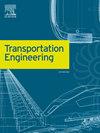Effect of aging kinetics on the fatigue behavior of asphalt mixtures incorporating various RAP contents
Q1 Engineering
引用次数: 0
Abstract
Aging significantly impacts the mechanical performance of asphalt mixtures, particularly in terms of fatigue resistance. Although several studies have investigated the fatigue behavior of asphalt mixtures with and without reclaimed asphalt pavement (RAP), limited research has studied the effect of aging kinetics on the fatigue resistance of asphalt mixtures containing RAP. This study investigates the impact of aging kinetics on the fatigue performance of asphalt concrete (AC) incorporating various RAP contents (0%, 20%, and 40%). All asphalt mixtures were subjected to short-term (STA) and long-term aging (LTA). The stiffness of asphalt mixtures was measured at 15°C and 20°C using the Indirect Tensile Stiffness Modulus (ITSM) test. The effect of aging on the stiffness was evaluated through the Aging Modulus Ratio (AMR). Fatigue performance was estimated using the Indirect Tensile Fatigue Test (ITFT) at 20°C. Recovered binders from AC were characterized using penetration, softening point, and Dynamic Shear Rheometer tests. A new method, comparing mixing rule predictions with real measured binder properties, confirmed full blending between virgin and RAP binders. The mechanical results indicate that the stiffness modulus increased significantly after both short and long-term aging for all mixtures, irrespective of RAP content. Additionally, reclaimed asphalt pavement addition increased the asphalt mixture stiffness for a given aging level. The asphalt mixture with 40% RAP showed greater resistance to aging based on AMR values. Furthermore, reclaimed asphalt pavement addition improved the fatigue performance of asphalt mixtures.
求助全文
约1分钟内获得全文
求助全文
来源期刊

Transportation Engineering
Engineering-Automotive Engineering
CiteScore
8.10
自引率
0.00%
发文量
46
审稿时长
90 days
 求助内容:
求助内容: 应助结果提醒方式:
应助结果提醒方式:


